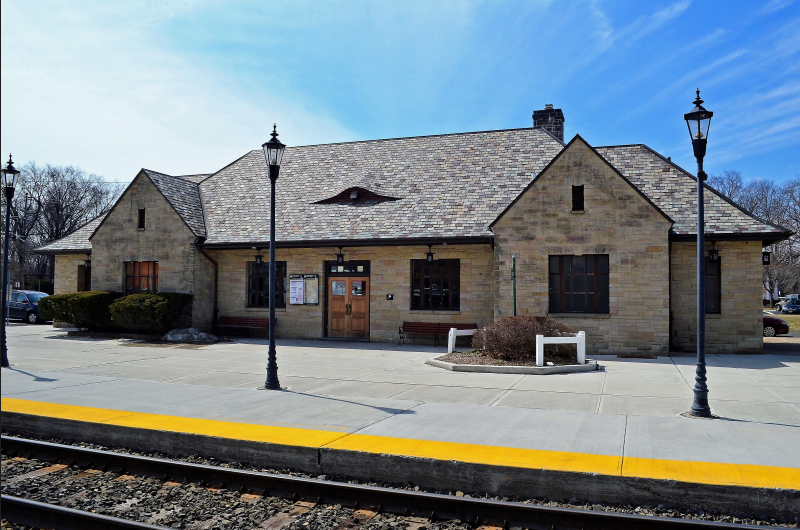
WESTWOOD, N.J.—The Westwood Historic Preservation Commission proudly announced on Feb. 4 the listing of the Westwood Train Station on the National Register of Historic Places.
The listing, which became official Jan. 28, recognizes the station’s “significance in relation to the development of Westwood and embodiment of distinctive architectural characteristics as an early 20th century commuter railroad station.”
There are more than 90,000 such sites listed nationwide, with more 1,700 in New Jersey and approximately 275 in Bergen County. The Westwood Train Station is the first listing on the National Register for Westwood.
The news reached Westwood Historic Preservation Chair Lauren Letizia and councilwomen Erin Collins and Beth Dell in a Feb. 3 congratulatory email from HPC preservation consultant Gregory Dietrich, who had drafted and submitted the application.
Formal notification from the New Jersey Historic Preservation Office is on the way, Dietrich said.
The National Register of Historic Places is the official list of the nation’s historic resources worthy of preservation. Established by Congress in 1966 under the National Historic Preservation Act, the Register includes districts, sites, structures, buildings, and objects of local, state, and national significance.
To mark the listing on both registers, the HPC is planning a public rededication ceremony in May during National Preservation Month.
According to Letizia, inclusion on the registers opens the property to grant opportunities and low-interest rehabilitation loans.
Listing also protects the property from public encroachment by requiring that any significant governmental undertakings involving the property must first be reviewed in order to prevent destruction or damage of the historic resource by a public agency.
“This is only relevant in the case of governmental action and is a condition that does not apply to privately owned property or private action upon a listed property,” Letizia told Pascack Press.
The station was one factor in Westwood scoring a “Great Downtown” nod by the New Jersey Chapter of the American Planning Association (APANJ) on Oct. 14, 2019.
The organization cited the station and surroundings in finding here “the gold standard of exemplary character, quality, and planning.”
With that recognition, Westwood joined a handful of awardees statewide—there were no others in Bergen County that year—having “a true sense of place, cultural and historical interest, community involvement, and a vision for tomorrow.”
Not your typical historic site
Letizia told Pascack Press the station is unique in that it’s owned by NJ Transit, with surrounding parkland owned by the Borough of Westwood. The station is an active stop along New Jersey Transit’s Pascack Valley Line. Its former ticketing and baggage areas serve as the headquarters for the Westwood Heritage Society, which holds weekly meetings in the space, maintains rotating display cases along the interior walls of the station, and hosts a museum from 10 a.m. to noon on the second Saturday of each month.
The listing includes Station Plaza and the eastern portion of Veterans Memorial Park as significant too.
The Westwood Train Station was added to the New Jersey Register of Historic Places in October 2018, marking the first State Register listing for the Borough. It joins nearly 200 historic sites in the county on the official list of the state’s historic resources of local, state, and national interest as established in 1970.
(See Westwood Train Station Nominated to Register of Historic Places, John Snyder, Aug. 3, 2018.)
Letizia told the mayor and council on Feb. 4, in presenting on a plan to leverage a historic site at 84 Washington Ave. in the service of local tourism and economic development, that the national listing is the culmination of a nearly 3.5-year-long initiative by the Westwood Historic Preservation Commission.
Initial research was begun by former HPC member and chair David Hohmann, who used—among many cited resources— archives of the Westwood Heritage Society.
Support was expressed by the Westwood governing body and the initiative championed by Letizia and HPC liaison Councilwoman Collins.
History steams ahead
The area that would eventually house the new station was owned by Westwood’s first fire chief, Genest M. Ottingnon, who deeded it to the Borough in 1914.
After significant delays, not least of which was WWI, Erie Railroad Architect Graham King was hired to design the station at a cost of $30,000 to be split between the Borough and Erie Railroad, plus $15,000 for site improvements including a small plaza, discreet parking lot to the south, a widening of Broadway between Jefferson and Irvington Avenues (now partially incorporated to the station parking lot) and demolition of a neighboring freight house.
At the time of its dedication in November 1932, there were approximately 150 stores in Westwood and the borough was evolving into a regional shopping destination.
In 1913, the Borough authorized the purchase, condemnation, or relocation of five properties located on the triangular parcel of land on the west side of the tracks running parallel to Broadway, just southwest of the existing station.
As part of this redevelopment, the Borough also planned for a new park to be known as Isaac D. Bogert Park, that would lie adjacent to the west of the new station. (This is now the area that encompasses the parking lot and bandstand. It is not included in the Register listings.)
The construction of the 1932 station was a culmination of a 20-year effort to replace an existing train depot in order to enhance downtown Westwood and attract new families looking to settle in the suburbs.
From 2008–2009, the station underwent a restoration, entailing the repair of its exterior walls, using the same Briar Hill stone from the original quarry in Ohio and its slate roof in kind.
According to the HPC, the station contributed significantly to the borough’s population surge of 4,884 in 1930 to more than 11,000 today, affirming Westwood’s identity as the “Hub of the Pascack Valley.”
— Drawn in large part from background by Lauren Letizia and the Westwood Historic Preservation Commission.
